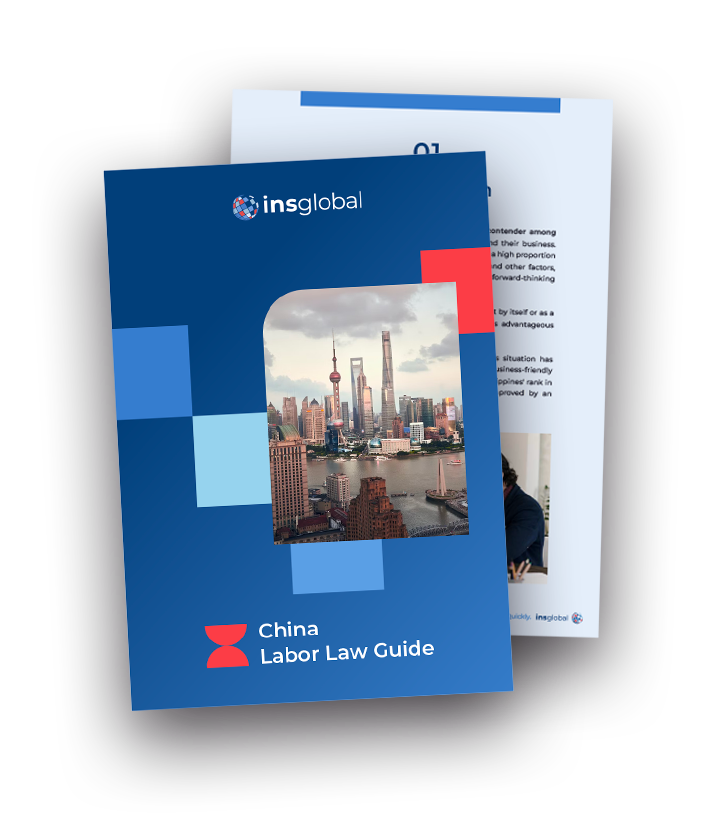Understand how the legal and fiscal system is applied in China and what are the requirements for foreign companies to be compliant.

Tired of scrolling? Download a PDF version for easier offline reading and sharing with coworkers
In a hurry? Save this article as a PDF
Tired of scrolling? Download a PDF version for easier offline reading and sharing with coworkers.
Fill up the form below 👇🏼
Filing Business Taxes
1. Tax Year
The Chinese tax year simply follows the calendar year. Similarly, there is no difference between tax quarters and calendar quarters.
2. Filing Due-Date
The statutory annual tax filing deadline for corporate income tax is 5 months after the end of the tax year.
3. Filing and Paying EIT Returns
Provisional EIT (Enterprise Income Tax) returns should be filed within 15 days of the end of every month or tax quarter, depending on the jurisdiction. They should be calculated on actual profits in that period. Business may be permitted to make calculations based on the average quarterly profit of the preceding tax year if they have difficulty calculating actual quarterly profits.
Businesses must file a company income tax return, even if it faced an overall loss. A finalized settlement of a business’s tax liability must be submitted within the final five months of the tax year. A business may contact local tax authorities to request an extension if they are unable to file returns on time. There must be a legitimate reason or special circumstance for late filings (such as abrupt changes in policy or an unexpected disaster).
Late Payment Charges
Business will face a fee for each day of late payments at .5% of the unpaid amount. Unpaid sums related to transfer pricing, thin capitalization requirements, and other anti-tax-avoidance adjustments may be subject to interest-based penalties.
Multiple Branches
For businesses with multiple branches in China, it is recommended, and usually required, that each branch, as well as the headquarters, file EIT returns individually.
Consolidated Returns
Consolidated returns are generally not permitted.
Statute of Limitations for Underpayment of EIT
- 3 years if the company’s underpayment of EIT is due to unintentional calculation error and amount of underpayment is less than 100,000 RMB.
- 5 years if the amount of underpaid tax is greater than 100,000 RMB.
- Up to 10 years if underpayment is due to transfer pricing issues.
- Tax evasion carries no statute of limitations.
4. Rulings
While advanced ruling procedures have been piloted in some special cases, they are not widely used.
Check Our China Labor Law Guide
Learn how the Chinese law is applied in all aspects and situations, from an employer and employee perspective

Guidelines for Tax Compliance
Related-Party Transactions
Chinese taxation authorities strictly monitor transfer-pricing practices to determine if related party-transaction resulted in a reduction in taxable income. Transaction with related parties must be conducted on an arms length basis.
Methods for Determining Arms Length: Taxation authorities may use any of the following methods for determining if a transaction was conducted at arms length:
- Comparable uncontrolled price method
- Resale price method
- Cost plus method
- Transactional net margin method
- Profit split method
- Other methods consistent with the arms length principle
Transfer Pricing Compliance Requirements
The State Administration of Taxation issued Bulletin No. 42 (in 2016) making transfer pricing compliance requirements relatively complex. In fact, transfer pricing compliance requirements in many cases exceed OECD standards.
RPT Forms
Businesses with significant related party transactions must annually submit related party transaction forms.
CbC Reporting
Businesses must submit a country-by-country report (CBCR) as a part of the overall transfer pricing documentation package. Submission of CBCR is required in any the following circumstances:
When the tax resident enterprise (TRE) is the ultimate holding company of a multinational enterprises’ group, with total consolidated revenue exceeding 5.5 billion RMB in the preceding fiscal year.
When the TRE has been appointed by the MNC to file the CBCR.
Special cases mentioned in article 8 o f the SAT Bulletin No.42 2016.

Master File
A master file, prepared by the company’s headquarters, outlining company transfer pricing policies, practices and all related business operations is required under some circumstances. Chinese subsidiaries should maintain this master file locally and translate it into Chinese. The requirement to submit a master file covers most businesses with international related-party transactions. Businesses are required to submit a master file under any of the following circumstances:
If the enterprise that has conducted cross-border related party transactions during the tax year, and the multinational enterprises’ group to which the ultimate holding company that consolidates the enterprise belongs, has prepared a master file.
The annual total amount of the enterprises’ related party transactions exceeds 1 billion RMB.
Local File
The Local File requirement is similar to that stipulated by OECD transfer pricing guidelines but must more extensive. Businesses are required to submit a Local File if related party transactions of tangible asset transfer exceeds RMB 200 million annually, related party transactions involving intangible assets or the transfer of financial assets exceeds RMB 100 million annually or if total related party transactions of other types (e.g. services transaction) exceed.
Definition of ‘Related Party’
A related party, as it were, exists in any of the following circumstances:
- When one party directly or indirectly owns 25% or more shares of the other party or a common third party directly or indirectly owns 25% or more of shares of both parties.
- A ‘related party’ exists with less than 25% ownership under any of the following circumstances:
- The total debt between both parties accounts for 50% or more of either party’s total paid-in capital.
- 10% of one party’s total debt is guaranteed by the other party (except for loans or guarantees from or between independent financial institutions).
- The business operations of one party depend on the proprietary rights, such as patents, non-patented technology know-how, trademarks, copyrights, etc., provided by the other party.
- The business activities, such as purchases, sales, receipt of services, provision of services, etc., of one party are controlled by the other party.
- More than half of the directors or senior management of one party are appointed or assigned by the other party, or simultaneously serve as directors or senior management of the other party; or more than half of the directors or senior management of both parties are appointed or assigned by a common third party.
- Two individuals who are spouses, related by lineal consanguinity, siblings, or other custodianship/family maintenance relationships have on of the relationships as specified above with one party and the other party respectively.
- Two parties have substantial common interests in other demonstrable ways.
Controlled Foreign Corporation (CFC) Rule
The CFC rule requires CFCs in low-tax jurisdictions with an effective tax rate of 12.5% or less may be taxed as part of the TRE. China’s tax authorities maintain a ‘white list’ of countries deemed not to be low-tax jurisdictions. TREs must file forms on overseas investments. If the annual profits of the CFC do not exceed RMB 5 million, the CFC rules do not apply.
- CFC Definition A CFC is defined as a non-Chinese company that is controlled by a Chinese tax resident. The controlling tax resident (whether a company or individual) would have a voting share greater than 10% and hold 50% or more shares.
Thin Capitalization Rule
The thin capitalization rule regulates related party financing, preventing excess interest expense deductions. The thin capitalization rule as applied to financial institutions specifies a debt-to-equity ratio of 5:1. For other businesses, the threshold is a debt-to-equity ratio of 2:1. Related party interest payments beyond this threshold are non-deductible. If a company is able to document that the financing is conducted at arms length or that the tax-rate of the lending entity is not lower than that of the Chinese borrowing entity, related-party financing beyond the threshold may be permitted at the discretion of taxation authorities.
General Anti-Avoidance Rules
The General Anti-Avoidance Rule requires that there be a bona fide business reason for any commercial plan or agreement that results in the reduction or deferment of taxable income.
Annual Audit
At the end of the tax year, companies are required under Chinese company law to prepare financial statements to be audited and certified by a Chinese registered CPA firm. In practice, smaller firms do not need to audit their financial statements.
Start your operations in China through our Employer of Record services. Contact us NOW!

SHARE